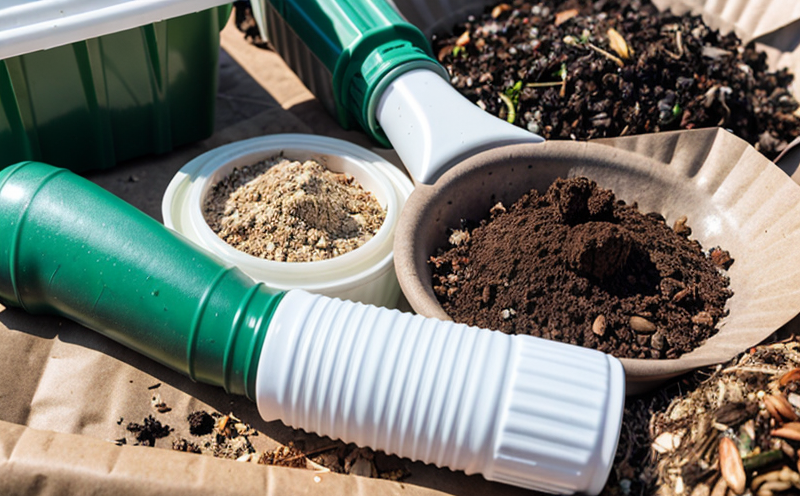EN 13699 Odor Emissions from Compostable Waste
The European standard EN 13699 specifies methods to determine the odor emissions produced by compostable waste materials during decomposition. This test is crucial for ensuring that products labeled as "compostable" meet environmental standards and do not release unacceptable levels of odors during their intended use or disposal.
Odor emissions are a significant concern in waste management, especially when dealing with organic and compostable materials. These emissions can affect the quality of life in residential areas, contribute to air pollution, and impact the acceptance of such products by consumers and regulatory bodies. Therefore, compliance with EN 13699 is essential for manufacturers looking to market their products as environmentally friendly.
The standard defines a series of tests that evaluate the odor intensity of compostable waste materials under controlled conditions. These tests are conducted in an air-tight chamber where the sample decomposes and releases volatiles, including odorous compounds. The emitted volatiles are then analyzed to determine their concentration and identify specific odorants.
For effective testing, samples must be prepared according to precise protocols outlined in EN 13699. This includes selecting appropriate waste streams, ensuring proper moisture content, and maintaining consistent temperature and humidity levels during the test. The duration of decomposition can vary depending on the type of material being tested but typically ranges from several days to a few weeks.
During testing, various instruments are used to capture and quantify odor emissions. Gas chromatography-mass spectrometry (GC-MS) is often employed to identify individual volatile organic compounds (VOCs), while olfactometry assesses human perception of the overall odor profile. Compliance officers and R&D engineers must ensure that their facilities have access to these sophisticated tools to accurately measure odor emissions.
The acceptance criteria for EN 13699 are stringent, reflecting the need to minimize environmental impact. The maximum allowable odor intensity is typically specified in terms of an odor threshold value (OTV), which represents the lowest concentration at which a person can detect the odor. If a sample exceeds this limit, it fails the test and cannot be labeled as compostable according to EN 13699.
Understanding the scope of this service is essential for manufacturers who wish to comply with international standards and ensure their products are accepted in various markets. For example, many municipalities have strict regulations regarding the types of waste that can be processed in municipal composting facilities. Products that do not meet EN 13699 may be rejected, leading to costly returns or recalls.
Another critical aspect is the impact on R&D engineers who are developing new compostable materials. By adhering to EN 13699, they can ensure their innovations will pass rigorous tests and gain market acceptance. Compliance with this standard also enhances a company's reputation as an environmentally responsible organization, which can translate into increased customer trust and loyalty.
For procurement teams, ensuring that suppliers meet the requirements of EN 13699 is vital to maintaining quality standards throughout their supply chain. Non-compliance by suppliers could lead to subpar products reaching the market, potentially damaging a company's reputation and legal standing.
In summary, compliance with EN 13699 is not merely a regulatory requirement but also a strategic decision that supports environmental sustainability and market competitiveness. By adhering to this standard, companies can ensure their compostable waste materials meet the highest quality standards and contribute positively to the environment.
Applied Standards
| Standard | Description |
|---|---|
| EN 13699 | This European standard specifies methods for determining the odor emissions produced by compostable waste materials during decomposition. |
| ISO 17225-3 | International standard that provides additional guidance on the measurement of volatile organic compounds in air. |
| ASTM D6840 | North American standard for biodegradable plastic products, which can complement EN 13699 by providing broader environmental assessment criteria. |
The application of these standards ensures that the testing methods are consistent and reliable across different regions. This consistency is crucial for manufacturers who operate globally and need to ensure their products meet local regulations in various countries.
Industry Applications
Compliance with environmental regulations in Europe and other regions that adopt this standard.
Evaluation of new compostable materials during the research and development phase.
Determination of odor emissions from waste streams destined for municipal composting facilities.
Quality assurance programs to monitor ongoing compliance with environmental standards.
The results of EN 13699 testing are widely used in the waste management and recycling sector. Municipalities rely on these data to select appropriate waste streams for composting, while manufacturers use them to refine their products and meet market demands. Procurement teams also leverage this information to ensure suppliers adhere to environmental standards.
Eurolab Advantages
At Eurolab, we offer comprehensive services for EN 13699 testing, ensuring that our clients receive accurate and reliable results. Our team of experts uses state-of-the-art equipment to conduct all necessary tests according to the specified standards.
Accurate measurement of odor emissions using gas chromatography-mass spectrometry (GC-MS) and olfactometry.
Comprehensive sample preparation and handling services to ensure consistent test results.
Expert interpretation of data, providing actionable insights for our clients.
We pride ourselves on offering a seamless testing process that minimizes disruptions and ensures timely delivery of results. Our facilities are equipped with the latest technology, ensuring accurate and reproducible test outcomes.





